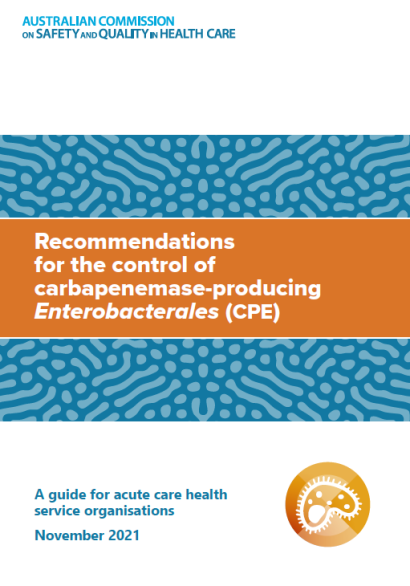Carbapenemase-producing organisms
This page includes information on infection prevention and control (IPC) strategies for carbapenemase-producing organisms (CPOs) and links to additional resources.
Overview
CPOs are bacteria that are resistant to a range of antibiotics. This includes carbapenems, which are primarily used as a last line treatment for serious gram-negative infections. CPOs include carbapenemase-producing Enterobacterales (CPE), Pseudomonas aeruginosa (P. aeruginosa) and Acinetobacter baumannii complex (A. baumannii complex).
Carbapenem resistance may be due to several mechanisms, including resistance to carbapenems, or the production of carbapenemase enzymes caused by the presence of specific resistance genes. There are a number of common carbapenemase genes. Five of the most important carbapenemase genes globally include imipenemase (IMP), Klebsiella pneumoniae carbapenemase (KPC), New-Delhi metallo-β-lactamase (NDM), oxacillinase group (OXA) and Verona integron-encoded metallo-β-lactamase (VIM). These genes have been identified in Australia.
Infection prevention and control practices should focus on limiting the spread of all CPOs, regardless of their specific resistance mechanism.
Management of CPOs in healthcare settings
CPOs have a high potential to cause outbreaks in healthcare settings. Strategies to prevent and control the transmission of CPOs in healthcare settings are:
- Planning, prevention and control
- Screening and surveillance
- Standard and transmission precautions
- Environmental cleaning and reprocessing reusable equipment
- Clearance
- Education.
Recommendations for the control of CPE
The Recommendations for the Control of CPE (the CPE Guide) provides a detailed focus on the management of CPE. This is because CPE is one of the most significant and preventable CPOs in Australia, accounting for around one-half of the critical antimicrobial resistances (CARs) reported to the National Alert System for Critical Antimicrobial Resistances (CARAlert). There is a high mortality rate related to CPE infections due their association with patients that have multiple morbidities and the limited availability of treatment options. The Commission has produced a range of resources to support the implementation of the recommendations of the CPE Guide:
- CPE: Information for patients
- CPE: Information for nurses and doctors
- CPE: Summary for health service organisations
- CPE Infographic: Australia’s growing CPE threat
The principles outlined in the CPE Guide specifically focus on the management of CPE. While similar principles may be relevant for other CPOs, tailored approaches to management may be necessary due to differences in the mode of infection transmission.
Additional resources
NSW
- Carbapenemase-producing Enterobacterales, New South Wales Health
VIC
- Victorian guideline on CPO for health services, Department of Health Victoria
QLD
SA
- Carbapenemase-producing Enterobacterales (CPE) infection control, South Australia Health
WA
- CPO (Carbapenemase-producing organisms), Department of Health Western Australia
- Screening and Management of Multi-resistant Organisms in Healthcare Facilities Policy, Department of Health Western Australia
TAS
- Healthcare associated infection surveillance, Department of Health Tasmania
Other
- Guidelines for the prevention and control of carbapenem-resistant Enterobacteriaceae, Acinetobacter baumannii and Pseudomonas aeruginosa in health care facilities, WHO
- Victorian guideline on CPO for long-term residential care facilities, Department of Health Victoria
- The Aged Care Infection Prevention and Control Guide (Chapter 2), Australian Commission on Safety and Quality in Healthcare
NSW
- Carbapenemase-producing Enterobacterales, New South Wales Health
VIC
- Victorian guideline on CPO for health services, Department of Health Victoria
QLD
SA
- Carbapenemase-producing Enterobacterales (CPE) infection control, South Australia Health
WA
- CPO (Carbapenemase-producing organisms), Department of Health Western Australia
- Screening and Management of Multi-resistant Organisms in Healthcare Facilities Policy, Department of Health Western Australia
TAS
- Healthcare associated infection surveillance, Department of Health Tasmania
Other
- Guidelines for the prevention and control of carbapenem-resistant Enterobacteriaceae, Acinetobacter baumannii and Pseudomonas aeruginosa in health care facilities, WHO
- Victorian guideline on CPO for long-term residential care facilities, Department of Health Victoria
- The Aged Care Infection Prevention and Control Guide (Chapter 2), Australian Commission on Safety and Quality in Healthcare

